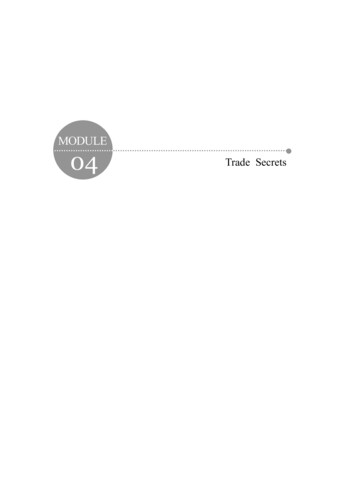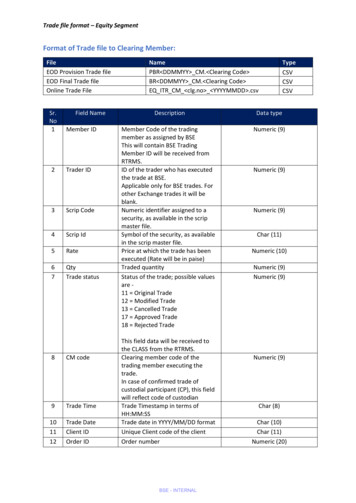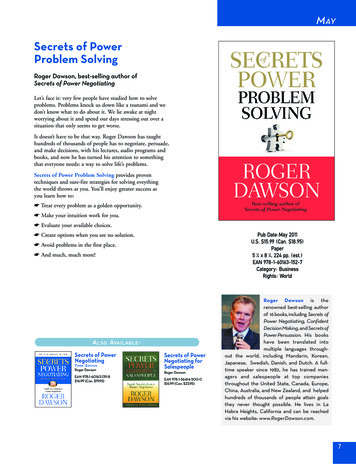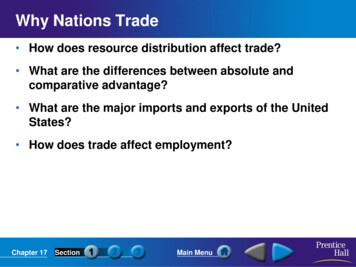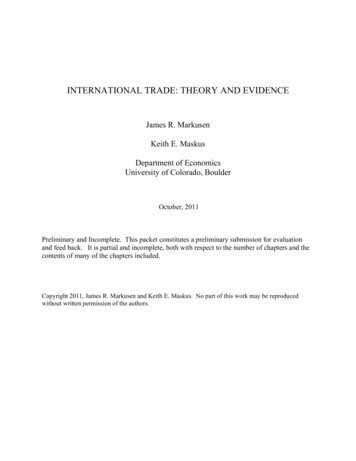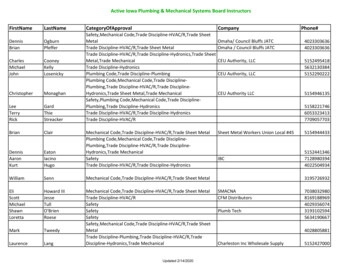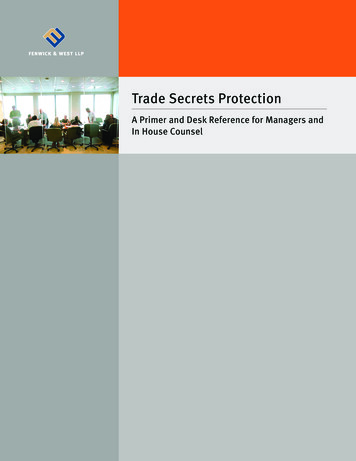
Transcription
Trade Secrets ProtectionA Primer and Desk Reference for Managers andIn House Counsel
About the FirmFenwick & West LLP provides comprehensive legal services to high technology andbiotechnology clients of national and international prominence. We have over 250 attorneysand a network of correspondent firms in major cities throughout the world. We have officesin Mountain View and San Francisco, California.Fenwick & West LLP is committed to providing excellent, cost-effective and practical legalservices and solutions that focus on global high technology industries and issues. Webelieve that technology will continue to drive our national and global economies, and lookforward to partnering with our clients to create the products and services that will help buildgreat companies. We differentiate ourselves by having greater depth in our understandingof our clients’ technologies, industry environment and business needs than is typicallyexpected of lawyers.Fenwick & West is a full service law firm with nationally ranked practice groups covering: Corporate (emerging growth, financings, securities, mergers & acquisitions) Intellectual Property (patent, copyright, licensing, trademark) Litigation (commercial, IP litigation and alternative dispute-resolution) Tax (domestic, international tax planning and litigation)Intellectual Property GroupFenwick & West’s Intellectual Property Group offers comprehensive, integrated adviceregarding all aspects of the protection and exploitation of intellectual property. Fromproviding sophisticated legal defense in precedent-setting user interface copyright lawsuitsto prosecuting arcane software patents, and from crafting user distribution arrangements onbehalf of high technology companies to implementing penetrating intellectual property audits,our attorney’s technical skills enable the Firm to render sophisticated legal advice.Our OfficesSilicon Valley CenterEmbarcadero Center West801 California Street275 Battery StreetMountain View, CA 94041San Francisco, CA 94111Tel: 650.988.8500Tel: 415.875.2300Fax: 650.938.5200Fax: 415.281.1350For more information about Fenwick & West LLP, please visit our Web site at: www.fenwick.com.The contents of this publication are not intended, and cannot be considered, as legal advice or opinion. 2001 Fenwick & West LLP. All Rights Reserved.
Trade Secrets ProtectionA Primer and Desk Reference for Managers and In House CounselTable of ContentsIntroduction. 1What is a Trade Secret? . 2Statutory Definition . 2Four Basic Elements . 2Examples of Trade Secrets. 3Technical Information . 3Business Information . 4Steps to Protect Trade Secrets. 4General Precautions . 4Considerations in Recruiting Employees . 5Considerations for Incumbent Personnel . 6Considerations in Terminating Employees . 7What is Misappropriation? .8Wrongful Acquisition . 9Wrongful Use .10Wrongful Disclosure . 11Loss of Trade Secret Status and Other Defenses . 12Readily Ascertainable Information . 13Remedies.13Civil . 13Criminal.14Choosing Between Civil and Criminal . 17
IntroductionCompanies sometimes overlook trade secrets as intellectual property assets because boththeir creation and continued existence depend upon secrecy. It is unlikely that a companywill issue announcements or press releases that a trade secret has been created. Unlikepatents, copyrights or trademarks, trade secrets are not publicly recognized or registeredwith the government.Thus, when managers and corporate counsel periodically take stock of their company’sintellectual property assets, they may fail to grasp the full extent of the company’s tradesecrets portfolio. Depending on the industry in which the company competes and thetechnology on which the company’s business is based, this oversight could be a costlymistake. The trade secrets portfolio may in fact be more valuable than all of the company’spatents, copyrights and trademarks combined.Trade secrets are easily misappropriated because they represent nothing more thaninformation, which can be memorized, scribbled down, e-mailed or copied onto sometangible medium and then quietly removed from company premises. Once trade secrets fallinto the hands of an unscrupulous competitor or former employee, they can be clandestinelyput to immediate use. Depending on the nature of the trade secrets, a competitor or formeremployee may be able to take and make use of the secrets without getting caught. Forexample, if the trade secrets involve a timesaving or cost-saving step for a manufacturingprocess, they could be implemented inside a competitor’s facility without the rightfulowner’s knowledge or suspicion.The mobility of the workforce in today’s knowledge-based economy heightens the risk ofmisappropriation. Employee turnover is rapid; and employers use consultants andcontractors even in highly sensitive jobs. But it is the company’s responsibility to protect itstrade secrets. Who is keeping track of what trade secrets these workers bring with themfrom their previous employers and what trade secrets they take when they leave?To police your company’s trade secrets portfolio, the first step is to acquire a workingknowledge of trade secret law in order to spot potential issues and problems. In California,as in most other states, a patchwork of state and federal laws (including case law)addresses the protection of trade secrets. The Uniform Trade Secrets Act provides a startingpoint in this analysis but it is by no means the exclusive source of law. This guide provides aquick reference to the basic laws and legal principles in California law. State trade secretslaws are similar but vary from state to state.fenwick & westtrade secrets protection1
What Is a Trade Secret?Like the majority of states, California has adopted a version of the Uniform Trade Secrets Act(UTSA). Enacted in 1984, the UTSA is codified under Section 3426 to 3426.11 of theCalifornia Civil Code.Statutory DefinitionThe version of the UTSA adopted by California defines a “trade secret” as follows:“Trade secret” means information, including a formula, pattern, compilation, program,device, method, technique, or process, that:(1) Derives independent economic value, actual or potential, from not being generallyknown to the public or to other persons who can obtain economic value from itsdisclosure or use; and(2) Is the subject of efforts that are reasonable under the circumstances to maintain itssecrecy.Four Basic ElementsEach of four elements must be present in a “trade secret”: A “trade secret” must consist of information. The types of information that have beenprotected by trade secret law are virtually without limit. The most common examples fallunder two categories: technical information and business information. In the next section,you will see some examples. The information must derive economic value (actual or potential) from the fact that it issecret. In other words it must have some value flowing from the fact that it is not known,and therefore cannot be put to use, by others. This value is independent of any intrinsicvalue that the information might have. To look at this element in still another way,information has the requisite independent economic value if a potential competitor orother interested person would have to expend time and money to find or develop it. The information cannot be generally known (either by the public, or, more importantly, byother persons in the industry). To be a trade secret, the information must not be generallyknown to the public, industry competitors, or others who could realize economic valuefrom its disclosure or use. Knowledge of the information in question by even a very smallnumber of outsiders (say, one key person) can deny or destroy trade secret status. As theComments to the UTSA state, “[i]f the principal person who can obtain economic benefitfrom information is aware of it, there is no trade secret.” Keep in mind, however, thatunique combinations of generally known concepts can be a trade secret.2trade secrets protectionfenwick & west
The information must be treated as a secret, and be the subject of reasonable effortsto maintain its secrecy. For information to acquire and maintain trade secret status, itsowner must exercise reasonable efforts to maintain its secrecy. The owner’s mere desireor intent to keep information a secret is not enough.But what efforts are considered “reasonable”? The comments to the UTSA state, “[t]hecourts do not require that extreme and unduly expensive procedures be taken to protecttrade secrets against flagrant Industrial espionage.”A California federal court has defined “reasonable efforts” to include “advising employees ofthe existence of a trade secret, limiting access to the information on a ‘need to know basis,’requiring employees to sign confidentiality agreements, and keeping secret documentsunder lock.” Requiring employees, contractors, visitors and other people who may come intocontact with trade secret information to sign confidentiality or non-disclosure agreementshelp to ensure that the information retains its trade secret status, because such agreementsimpose on their signers a contractual duty not to disclose the information.Examples of Trade SecretsTrade secrets largely fall into two broad categories: technical information and businessinformation. The lists below are not intended to be exhaustive or exclusive. Keep in mindthat technical or business information falling under one of the classes listed below must stillsatisfy the other elements of a trade secret in order to meet the legal definition.Technical InformationTrade secrets in this category may include: Plans, designs and patterns, such as those for specialized equipment Processes and formulas, such as those for the manufacture of drugs, foods, chemicals orother materials (e.g., the formula for Coca-Cola) Methods and techniques for manufacturing Engineering notebooks Negative information, e.g., the designs that didn’t work (the UTSA definition of a tradesecret “includes information that has commercial value from a negative viewpoint,for example the results of lengthy and expensive research which proves that a certainprocess will not work could be of great value to a competitor”) Computer software (programs or source code)fenwick & westtrade secrets protection3
Business InformationTrade secrets in this category may include: Financial information prior to public release Cost and pricing information Manufacturing information nternal market analyses or forecasts Customer lists Unannounced business relationships one is negotiating or has entered into Information about business opportunities, such as opportunities to acquire anothercompany or product Marketing and advertising plans, both for existing and planned products Personnel information (e.g., who the key employees are, what are the compensation plansfor key employees, who would be a good target to hire away because of his or her specialknowledge, experience, receptivity to solicitation, and the like)Steps to Protect Trade SecretsGeneral PrecautionsTrade secret owners have a duty to use “reasonable measures” to safeguard their secrecy. Acommon “reasonable measure” involves putting employees, contractors, vendors and otherpersonnel on notice of the existence and nature of confidential information, and of acontractual duty on their part not to disclose it. Companies may include confidentialityprovisions in form contracts, offer letters, requests for bids, and other appropriatedocuments.Give workers (both employees and contractors) guidelines as to what sort of information thecompany considers confidential and how that information should be treated. Require themto sign non-disclosure agreements. Place warning labels on confidential documents andcomputer login screens. Issue periodic confidentiality reminders to workers as appropriate.In pursuing business opportunities, disclosures of trade secret information should occurunder a license or non-disclosure agreement (itself a confidential document) that describesthe information that is being disclosed; states the purpose(s) for the disclosure and thepermitted exclusive use(s) of the information; and reiterates the other party’s obligation tomaintain the secrecy of the information. Vendors, suppliers, and independent contractingorganizations or subcontractors should sign non-disclosure agreements at the inception ofany relationship.4trade secrets protectionfenwick & west
If an agreement is not possible, the trade secret owner should at least make clear itsexpectation that information is treated as confidential.Although any protection measures must address specific risks applicable in that businessand industry, extreme and unduly expensive procedures are not required. Beyond theobvious step of limiting access to confidential information to a “need to know” basis,following is a list of minimum practical “reasonable measures”: Mark confidential documents and materials as such. Put locks on doors and file cabinets (or other forms of restricted access to physical files). Issue employee ID badges. Have specific procedures for visitors (signing in and out, visitor badges, no unescortedvisitors). Require security passwords for computers and networks and limit access thereto. Provide a strong trade secret policy statement in employee handbooks. Have employees, contractors and third parties sign non-disclosure agreements. Do not discuss confidential information (including “hot projects”) during interviews andlimit tours of the facility (or have the applicant sign a nondisclosure agreement). Develop a matrix that classifies employees, consultants, contractors, and vendorsaccording to the degree of access that they require and have been given to sensitiveinformation.You may find it necessary to take additional steps in specific areas, or with respect tospecific kinds of information, such as limiting or monitoring the copying of documents ordata in particular departments, prohibiting the removal or distribution of certain kinds ofdocuments outside of a specific location, or prohibiting or limiting an employee fromcopying or working on company materials on their home computers.Considerations in Recruiting Employees Instruct each person involved in the recruiting and hiring process not to use anyconfidential information belonging to his or her own former employers, and to use goodjudgment and caution when recruiting former co-workers from those employers. Similarly, do not use any proprietary information belonging to another business entitywhen seeking out and retaining independent contractors. New hires should be counseled not to bring with them or to use any information ormaterials belonging to another company, such as telephone directories, organizationalfenwick & westtrade secrets protection5
charts, salary schedules, and the like, as well as technical and business information thatwere protected as confidential by that company. If a current employee has signed a non-solicitation clause with his or her formeremployer, he or she may be prohibited from soliciting former co-workers to join him orher at your company. These non-solicitation agreements may be enforceable. If made inCalifornia, such agreements are enforceable only to the extent that they are necessary toprotect the former employer’s trade secrets. If a prospective employee has entered into a non-competition agreement with his or hercurrent or former employer outside of California, that agreement may be enforced if it waslawful at the place and time it was made. You should question job applicants to find outwhether they are bound by such an agreement and if so, ask to see a copy of it. Have applicants sign a statement confirming that they will not bring to their new job anyconfidential or proprietary information or trade secrets from their former employer, andthat they will not reveal any such information either during the recruitment process orafter being hired. In interviewing technical personnel in particular, interviewers should be careful not to“pump” an applicant for information about how his or her current employer conducts itsbusiness or the details of any of the employer’s projects. Once applicants are far enough along in the interview process to be told specifics aboutthe confidential operations of your company, have them sign a confidentiality agreement.Considerations for Incumbent Personnel Once an employee is hired, he or she should sign a confidentiality and inventionassignment agreement. Any incumbent employees who have not already signed suchan agreement should sign one immediately as a condition of further employment. Theemployer may offer additional consideration such as a salary increase, promotion or bonusat the time the confidentiality agreement is signed in order to ensure there is adequateconsideration for such an agreement from employees who are not at will. Consider having independent contractors sign confidentiality and invention assignmentagreements that limit the kinds of other customers for whom they may work, both duringand after the engagement. It may also be advisable to require them to agree to discloseidentities of concurrent and future clients for a period of time after the contract ends. Make sure that incumbent employees and independent contractors are made aware andreminded of trade secret and confidentiality obligations through the dissemination ofpolicy statements, memoranda and notices; the use of sign-on screens on computersand labels on binders and materials; and the promulgation of a confidentiality and tradesecret policy, which should be made a part of the company employee handbook.6trade secrets protectionfenwick & west
Considerations in Terminating EmployeesOne way in which businesses often try to protect their confidential information is byimposing non-competition agreements on departing employees and contractors. But inCalifornia and some other states, this option usually is not available. California’s strongpublic policy against non-competition agreements is embodied in Business & ProfessionsCode section 16600:Except as provided in this Chapter, every contract by which anyone is restrained fromengaging in a lawful profession, trade or business of any kind is to that extent void.Thus, the general policy in California is that an employer or contractor may not require anemployee, subcontractor or vendor to sign a post-termination non-competition agreement.The doctrine of inevitable disclosure, under which a trade secret owner may be able toenjoin the subsequent competitive employment of a former employee for a certain period oftime, is not recognized in California because it offends this general policy, although it isrecognized in some states.In a non-solicitation agreement, one party agrees not to solicit or induce employees orcustomers (as the case may be) of the other party. Such agreements are generally executedbetween an employer and an outgoing employee (or between a principal and a departingcontractor). The departing employee agrees that he or she will not solicit the formeremployer’s remaining employees for the new employer, or solicit business from the formeremployer’s customers (or both) for a specified amount of time. These agreements areusually enforceable, although in California they are only enforceable to the extent necessaryto protect the former employer’s trade secrets. If it appears that trade secrets are being usedin the solicitation, the agreements can be enforced.Protective measures a company should take upon the departure of an employee orindependent contractor include: Give every departing employee and independent contractor an exit interview, duringwhich the worker should return his or her access card, keys, passwords and the like. He orshe should also return any documents or things in his or her possession, including thingskept at home (such as company files on his or her home computer), in the car, as wellas in his or her office or work area. In addition, disable the worker’s access to voicemail,electronic mail, all computer access and access to other information and materials. During the exit interview, give the worker a copy of the confidentiality agreement thathe or she signed upon joining the company, and remind him or her that the obligationsunder that agreement continue even after termination of employment or engagement.fenwick & westtrade secrets protection7
Conduct a review of the employee’s or independent contractor’s work area as part of theexit process. Have the worker point out and show the location of confidential materialsthat he or she usually worked with, including data on his or her computer. Usually theimmediate manager is the person who best knows what that worker should or should nothave in his or her possession and can be sure that everything is accounted for. Do not wipe the hard drive of any workstation, desktop or laptop of the departing workerthat is being returned to the company’s inventory without making sure that all files onthe hard drive that need to be kept have been appropriately archived. After archiving, thehard drive should then be “wiped” so that no file can be resurrected. If the equipmentis to be used by the departing worker’s replacement, care should be taken to delete anydeparting worker’s personal information that may be contained on the hard drive. Do not allow an employee or independent contractor in a sensitive position to stay onthe job for any length of time after he or she has given notice of his or her intention toquit. Particularly if the worker is going to work in a similar or related industry, acceptthe resignation immediately and terminate the employment or engagement as soonthereafter as possible. This allows less opportunity for the worker to remove or pass alongconfidential data. After an employee or independent contractor has given notice, the company may monitorelectronic mail access, as well as building access logs to determine if the worker hasbegun to come to the facility at odd times or has been staying in the facility for unusuallyextended periods of time. The company may also wish to monitor photocopying or the useof other office supplies that might indicate that the worker is copying data.What Is Misappropriation?Misappropriation does not need to be a deliberate act; it can occur through negligence oreven mistake. “Misappropriation” is a statutory term that defines what one may not do withtrade secrets one does not own. Section 3426.1(b) of the UTSA reads:“Misappropriation” means:(1) Acquisition of a trade secret of another by a person who knows or has reason to knowthat the trade secret was acquired by improper means; or(2) Disclosure or use of a trade secret of another without express or implied consent by aperson who:(A) Used improper means to acquire knowledge of the trade secret; or(B) At the time of disclosure or use, knew or had reason to know that his or herknowledge of the trade secret was:8trade secrets protectionfenwick & west
(i) Derived from or through a person who had utilized improper means to acquireit;(ii) Acquired under circumstances giving rise to a duty to maintain its secrecy orlimit its use; or(iii) Derived from or through a person who owed a duty to the person seekingrelief to maintain its secrecy or limit its use; or(C) Before a material change of his or her position, knew or had reason to know thatit was a trade secret and that knowledge of it had been acquired by accident ormistake.This definition of misappropriation can be broken down into three types of prohibitedconduct: (1) wrongful acquisition, (2) wrongful use, and (3) wrongful disclosure of someoneelse’s trade secret. Each of these is discussed separately below. However, a common threadtying all of these concepts together is “improper means.”The UTSA expressly defines “improper means” to include “theft, bribery, misrepresentation,breach or inducement of a breach of a duty to maintain secrecy, or espionage throughelectronic or other means.” The Comments to section 3426.1 provide a broader example:“Improper means could include otherwise lawful conduct which is improper under thecircumstances; e.g., an airplane overflight used as aerial reconnaissance to determine thecompetitor’s plant layout during construction of the plant.” Using authorized access to anetwork or computer system to obtain unauthorized access to information on the network orin the system would also be an example of “improper means.”Importantly, the plain language of the statute and the Comments emphasize that bothreverse engineering and independent development are not misappropriation. The Committeenotes define reverse engineering as “starting with the known product and working backwardto find the method by which it was developed. The acquisition of the known product must ofcourse, also be by a fair and honest means, such as purchase of the item on the openmarket for reverse engineering to be lawful.” Additionally, the Comments provide thatdiscovery of the trade secrets under license by the owner, observation of the purported tradesecret in public use, or obtaining it from published literature are “proper means” andtherefore not misappropriation.Wrongful AcquisitionMisappropriation by wrongful acquisition occurs when all of the following conditions are met: The acquisition of a trade secret of another; By a person who knows or has reason to know; andfenwick & westtrade secrets protection9
That the trade secret was acquired by improper means.A person who obtains by subterfuge or outright taking any information he has reason toknow is confidential, is guilty of misappropriation. If a person obtains information directly orindirectly from someone who does not have authority to disseminate it, that person may beliable for misappropriation by wrongful acquisition.Here are some examples of misappropriation by wrongful acquisition: Copying and removing trade secret documents from their storage location. Obtaining trade secret information from the trade secret owner’s employee, if thatemployee had an obligation to maintain the information in confidence. Improper surveillance.Similarly, the employer of an employee who wrongfully acquires and uses a trade secret onthe job (e.g., by bringing it from his or her old job) is liable to the trade secret owner formisappropriation and may also be subject to criminal penalties. See the discussion below.Breaching or inducing another person to breach a duty to maintain confidentiality is anothercommon problem. One who obtains confidential information, but knows or has reason toknow that the source is under an obligation not to disclose such information, can be liablefor misappropriation. The fact that a person under such an obligation willingly oraccidentally disclosed the information does not protect the recipient.Lawful acquisition of another’s trade secrets, without more, is not actionable. The tradesecret owner must show the defendant used “improper means” (discussed above) to acquirethe information in order to show liability for this type of misappropriation.Wrongful UseMisappropriation by wrongful use occurs where:(1) One uses the trade secret of another person;(2) Without the express or implied consent of the owner of the trade secret; and at leastone of the following is true:(a) The trade secret was obtained by improper means (for example, you stole theinformation or employed other improper means to get it such as implanting andusing a “backdoor” or “hook” in a computer program, system or network); or10 trade secrets protectionfenwick & west
(b) The trade secret was obtained from another person who used improper means toobtain it (for example, at the time of use, you knew or had reason to know that yougot the information from or through a person who stole it, or used other impropermeans to obtain it); or(c) The trade secret was obtained from a person who had an obligation not todisclose it (for example, at the time of use, you knew or had reason to know thatyou got the information from a person who was under an obligation–whether by anondisclosure agreement or otherwise–not to disclose it to you); or(d) You obtained the trade secret under an agreement or obligation not to use it inthe way you are using it (for e
under a license or non-disclosure agreement (itself a confidential document) that describes the information that is being disclosed; states the purpose(s) for the disclosure and the permitted exclusive use(s) of the information; and reiterates the other party's obligation to maintain the secrecy of the information.

